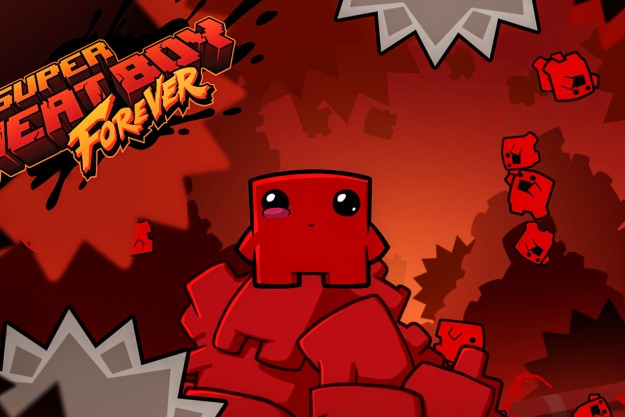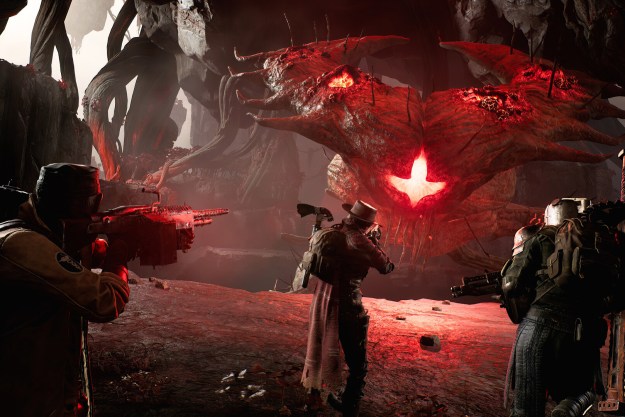
“Super Meat Boy Forever does for endless runners what Super Meat Boy did for platformers.”
- Super simple controls
- Smart checkpoints
- Tough but fair levels
- New mechanics work extremely well in runner formula
- Tons of saws
- Runner game veterans might burn through it quickly
When Super Meat Boy was released seven years ago, its super-responsive controls and demanding platforming breathed new life into one of gaming’s oldest genres. Just over a decade later, the follow-up, Super Meat Boy Forever is gearing up to apply the same principles to a new well-liked, but seemingly tapped-out form: the endless runner.
Super Meat Boy Forever was originally created as a mobile spin-off, before developer Team Meat fleshed out the concept, turning it into a full-fledged sequel. Though it’s now described as “a console game being released on mobile,” rather than the other way around, the underlying mobile sensibility is still obvious.
Endless runners — side-scrolling platformers in which a character constantly and automatically moves forward — have become a mobile game standard, thanks to games like Canabalt, Temple Run, and Super Mario Run. Even the toughest among them work well on a smartphone, as they demand intense focus, rather than mastery of complex control schemes.
Those same player priorities — focus and attention to detail — are essential in the original Super Meat Boy as well, which may explain why Super Meat Boy Forever feels like a perfect fit for the genre. Meat Boy, a smiling red square slab with arms and legs, runs through each of the game’s levels toward the goal, avoiding saw blades and buzzing enemies that are ready to murder him with a single touch.
Super Meat Boy Forever is incredibly easy to pick up, and ultimately, pretty addictive.
Forever is technically not an endless runner; every level has a clearly defined end goal and specific challenges along the way, but it borrows much of what defines the genre. Most notably, that the game only uses two buttons. On the PlayStation 4, pressing X makes Meat Boy jump, and pressing it again makes him punch. Pushing down on the analog stick makes him slide. That’s it.
Super Meat Boy was known for being hard, requiring precise movements and timing in order to make it through its ridiculously lethal levels. Super Meat Boy Forever is just as difficult, with the same sort of requirements. Hold the jump button down for too short or too long a time, and Meat Boy careens into a buzzsaw, or off a cliff.
Despite the steep learning curve, the game itself is easy to pick up. There are only a few mechanics to master — jumping, sliding, dashing forward by throwing a punch in mid-air, and sliding down or jumping off walls. Everything comes down to timing and reflexes. The accessibility that would have been essential on a phone makes the console version of Super Meat Boy Forever incredibly easy to learn, and ultimately, pretty addictive.
Those streamlined mechanics work because of the game’s extremely smart level design, which provides an intense challenge reminiscent of the original Meat Boy, but tuned for the game’s new mode of play. The levels are procedurally generated, though each one is algorithmically built with an eye toward creating a rhythm. You’ll jump over saws, dive under enemies, and bounce off walls, but the game never feels designed to punish you or take cheap shots by piling on the obstacles.
Yes, you’ll die a lot along the way, getting thrashed by deviously placed saw blades and dangers you didn’t see coming. But Super Meat Boy Forever always has a handy checkpoint immediately (or almost immediately) before the obstacle you couldn’t beat. And the game resets at a breakneck speed, letting you try, and die, over and over and over again.
The result is an eminently playable game, challenging but not frustrating, throwing obstacles at players and then giving them just enough time to breathe before challenging them again. Super Meat Boy Forever constantly pushes your skills, but your success always feels actively rewarding. When you get through a tough portion or level, you’re always ready to move on to the next thing.
If all of Super Meat Boy Forever is as well-built as the first 10 or 15 levels we tried at PlayStation Experience 2017, it’ll be a worthy successor to the original.
Super Meat Boy Forever is currently set hit PlayStation 4, Nintendo Switch, Xbox One, PC, iOS, and Android in summer 2018.
Editors' Recommendations
- When is Stardew Valley 1.6 coming to consoles?
- Is Minecraft cross-platform?
- The best cozy games
- The best single-player games
- Where to find planes in Fortnite OG






